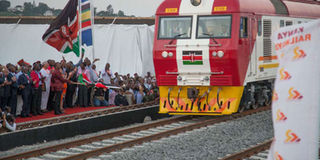Second phase of SGR to be completed next year

President Uhuru Kenyatta launches the cargo freight services of the Standard Gauge Railway at Port Reitz Station in Mombasa on May 30, 2017. The second phase will be completed next year. PHOTO | WILLIAM OERI | NATION MEDIA GROUP
What you need to know:
- The SGR is expected to eventually connect Nairobi to Kampala via Naivasha, Kisumu and Malaba.
- Prof Maringa said the recent chaos by the Maasai community will not affect the set timeline.
The construction of the second phase of Standard Gauge Railway from Nairobi to Naivasha will be completed in September next year.
The government had targeted to complete the construction on December 2019 but a review in the plans showed it will be completed three months before the set deadline.
“Both the rail and the special economic zone should be operational by the end of 2019,” Transport Principal Secretary Paul Maringa said.
The 120-kilometre Nairobi-Naivasha line will cost the taxpayer Sh150 billion.
It connects to the recently completed stretch from Mombasa port to Nairobi.
The SGR is expected to eventually connect Nairobi to Kampala via Naivasha, Kisumu and Malaba.
MAASAI JOBS
In an interview with Nation in Mombasa, Prof Maringa said the recent chaos by the Maasai community will not affect the set timeline.
The community had staged protests demanding jobs from the mega project.
One person was shot dead on January 7 during the protests.
The victim was among a group of youth who tried to storm the construction site protesting that locals had not benefited from the project.
The ongoing construction had faced hitches as bad blood between the local community and the Chinese firm constructing the second phase threatened to boil over.
SKILLS
The early entry of the Chinese contractor at the SGR line before land owners were compensated caused friction with the local community, resulting in further delay of the endeavour.
However, the PS said the challenges occasioned by the demonstrations have led to serious engagements and networking with local political leadership in Kajiado and Narok counties.
“We have developed a consultative framework to ensure that locals feel they are an integral part of the SGR,” he said.
He cited lack of skills as a challenge hindering locals from being employed.
But he assured them that they would be trained and employed.





